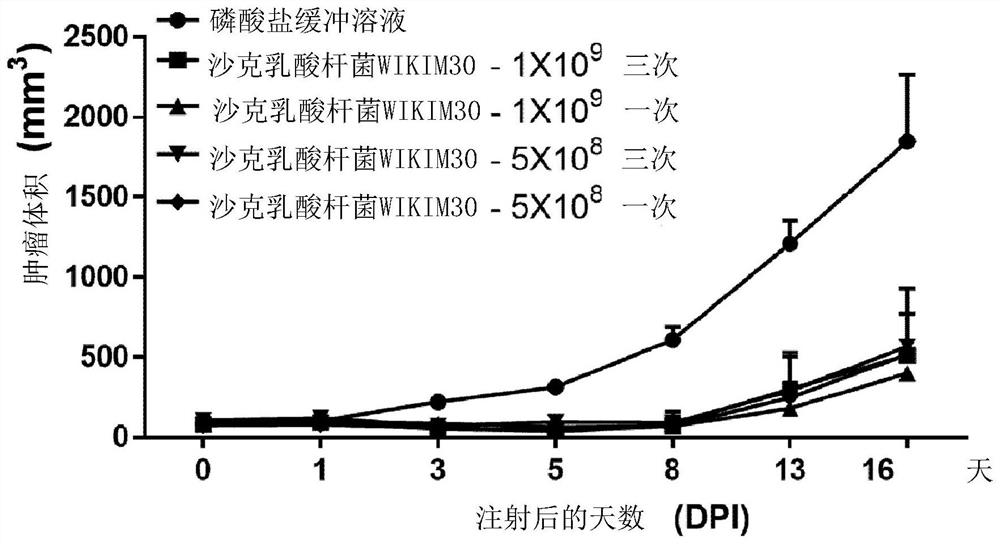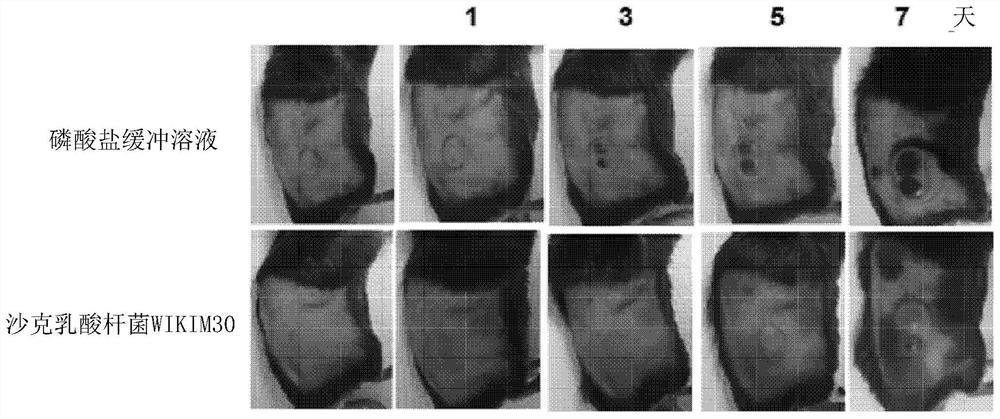Pharmaceutical composition comprising lactobacillus sakei wikim30 as active ingredient for prevention or treatment of cancer
A technology of Lactobacillus sarketi and active ingredients, which is applied in the direction of medical preparations containing active ingredients, Lactobacillus, drug combinations, etc., can solve the problem of no anti-cancer activity and excellent report of Lactobacillus sarketi, and achieve excellent The effect of anticancer activity
- Summary
- Abstract
- Description
- Claims
- Application Information
AI Technical Summary
Problems solved by technology
Method used
Image
Examples
Embodiment 1
[0059] Embodiment 1. Isolation and cultivation of bacterial strains
[0060] Lactobacillus sarkeri WIKIM30 (preservation number: KCCM11878P) was obtained from the microbial gene bank of the World Kimchi Research Institute for experiments.
[0061] After the single bacterium colony of the obtained Lactobacillus sarkeri WIKIM30 was subcultured in the MRS agar (agar) medium, after cultivating at a temperature of 30° C. for 48 hours, the single bacterium colony of the culture was inoculated in the MRS liquid medium of 10 ml, Incubate at a temperature of 37° C. with shaking at a frequency of 200 rpm for 24 hours. After culturing, the culture medium was removed by centrifugation at 8000 rpm for 5 minutes, and washed three times with phosphate buffered saline (PBS, Phosphate Buffered Saline) to remove remaining medium components.
Embodiment 2
[0062] Embodiment 2. Conditions of experimental animals (mice)
[0063] The experimental animals used in the experiment were male 5-week-old BALB / c mice and C57BL / 6 mice (ORIENT BIO Company, Korea), which were kept in a specific pathogen-free ( After a stabilization period of 1 week in an animal breeding room in a SPF) environment, rearing was carried out during the experiment. Feed was provided as plain tray feed without added antibiotics, and water was provided in a ready-to-take form. Experiments All animal breeding, experimentation and euthanasia were carried out in accordance with protocols approved by the World Kimchi Research Institute Animal Experiment Ethics Committee. The observation of tumor size changes uses the method of 3.14×(length×height×width) / 6 to measure the tumor volume (mm 3 ).
Embodiment 3
[0064] Embodiment 3. Preparation of CT26 mouse colorectal cancer cell transplantation animal model
[0065] 3-1. Cell culture
[0066] CT26 mouse colorectal cancer cells (Korean Cell Line Bank, Korea) were purchased and used. Using DMEM medium (Hyclone Company, USA) containing 10% fetal bovine serum and 1% penicillin-streptomycin (Hyclone Company, USA), in 5% CO 2 1. Cultivate CT26 mouse colorectal cancer cells at 37°C.
[0067] 3-2. Preparation of cell transplantation cancer animal model
[0068] In order to prepare an animal model of CT26 cell transplantation, 6-week-old BALB / c mice (18g-21g) were used in the experiment. Get (harvest) 1×10 5 Cells of cultured mouse colorectal cancer cell CT26 were resuspended in 50 μl of phosphate buffer solution, and injected subcutaneously into the right thigh of the mouse.
PUM
 Login to View More
Login to View More Abstract
Description
Claims
Application Information
 Login to View More
Login to View More - R&D
- Intellectual Property
- Life Sciences
- Materials
- Tech Scout
- Unparalleled Data Quality
- Higher Quality Content
- 60% Fewer Hallucinations
Browse by: Latest US Patents, China's latest patents, Technical Efficacy Thesaurus, Application Domain, Technology Topic, Popular Technical Reports.
© 2025 PatSnap. All rights reserved.Legal|Privacy policy|Modern Slavery Act Transparency Statement|Sitemap|About US| Contact US: help@patsnap.com



